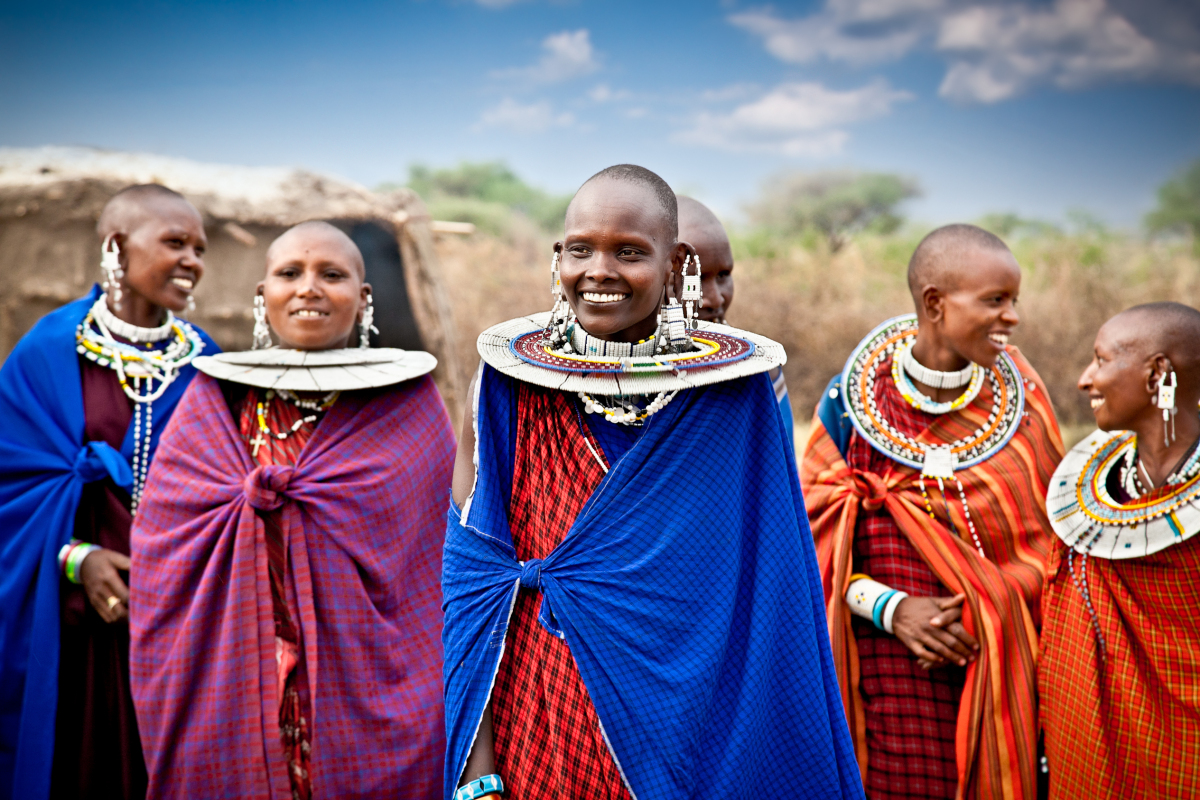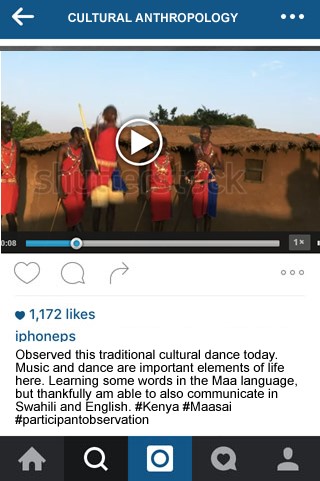Thinking like a Social Scientist
Collecting Research in the Social Sciences
MINDS ON
Do you know anything about the Maasai people? Take a minute and click on the who, what, and why images to learn more about the people and their culture.


The Maasai are a tribe of people who live in parts of Tanzania and Kenya (in Africa) and are known as tall and fierce warriors.
- They can be recognized by the special red cloth they wear which is called a Shuka.
- Maasai people live a nomadic life, which means they move from place to place with their animals.
- They rely on their animals for food (including milk, meat, and animal blood) and walk for many miles with their animals to find fresh food and water. They get all the other foods they need by trading (swapping) with other Maasai people.
- Maasai men herd cattle and carry spears to protect their cattle from wild animals such as lions.
- The Maasai women are responsible for cooking, collecting sticks for the fire, and building the home.
Where do the Maasai people live?
In Kenya, most Maasai people live in the Maasai Mara Reserve, which is a large park in the South West of Kenya. It is named after the Maasai people who live there and the Mara River which cuts through the park.
- The Maasai live in shelters called manyatta which are built from branches and grass.
- Maasai homes do not have windows or chimneys so it is dark and smoky inside.
- Animal skins are laid on the floor and are used for warmth.
- There is no electricity or running water.
- When food and water run out, the Maasai pack up their homes and walk across the land to a place where there is food and water for their animals.
Why is the Maasai Mara Reserve so important?
The Maasai Mara Reserve is a large protected park and is important because:
- Many animals including lions, rhinos, giraffes, zebras, warthogs and buffaloes live there.
- The animals are protected by the Government of Kenya so nobody can go and hunt them.
- Many tourists from other countries visit the area to see the animals in their natural habitat. A habitat is a place where a plant or animal usually lives. Tourists go on a ‘Safari.’ Safari is the Swahili word for journey. This brings large amounts of money to the country.
- All of the animals and plants in the reserve are part of a special ecosystem. An ecosystem is an area where plants and animals live in balance with the environment.
Source: Factsheet
Now, watch this video about Richard Turere, who is a member of the Maasai tribe:
Before watching the video, you may have thought that you had nothing in common with Richard Turere or the Maasai people - but, is that actually true?
Task: Contribute one example (in each section) to each of the three different Venn Diagrams to compare and contrast what you have learned about behaviour, society, and culture.
Venn_Behaviour_Society_Culture
 Stop and Reflect
Stop and Reflect
Why is it beneficial to learn about each other's behaviours, societies, and cultures? How does learning about these topics make us global citizens(definition: Global citizenslearn from and with diverse people)?
ACTION
The Social Science Inquiry Model
Collecting research in the social sciences occurs in different ways, using different research methods. Researchers in each discipline collect data using research methods that are special to their subject(s). But all social science researchers - regardless of the discipline - use the same steps in their research plans.
Whether they are studying behaviour, society, or culture, social scientists all take a systematic approach in their studies. A systematic approach means that all researchers follow the same, clearly defined, steps when they approach their investigations. Speaking of steps, working through the Social Science Inquiry Model is similar to walking up a set of stairs - you must complete one step before advancing to the next!
As we work through an example of the Inquiry Model, you will be able to draw from your bank - your knowledge bank, that is. You will notice that the knowledge and understanding of key topics (e.g., ethics, critical literacy, questioning skills, etc.) that you have already gained in this course will help you better understand each of the steps involved in the process.
Step 1: Define The Question
After identifying a topic that they are interested in, or curious about, researchers must define the question that they will investigate - the question that drives the research. Throughout the investigation, the research that is collected by these social scientists will be used to try to answer the research question. As you see, the research question is very important because it establishes the framework or structure that shapes all the other steps in the research project.
What Makes a Good Research Question?
Below are the criteria for good research questions.
Focus
The research question must include:
-
references to the researcher's topic, itself (e.g., teenagers and future plans, or teenagers and goal setting); and
-
the key parameters (conditions) of the research (e.g., Who is being studied? Location of the study? Timeframe? Ages? Gender or sex?, etc.).
Clarity
The research question must:
- be written in plain and simple language; and
- not include words or terms that people may not understand (e.g., slang or jargon).
Richness
The research question must:
- be presented in an interesting way (to make people curious enough to want to participate in your study/research);
- not be too general/broad or too narrow/specific;
- start with ‘why,’ ‘how,’ and ‘what,’ to ensure a research process (and it must be an open-ended question!);
- not contain unproven, negative, or stereotypical assumptions about other people, groups, or cultures (recall the topics of ethnocentrism and critical literacy!); and
- not be a leading question (i.e., a question that influences subjects’ responses). For example, if you asked, "What are the negative effects of playing video games?" your study would not be objective because you would not be investigating different - positive - effects of video games, as well. Instead, the question could be better worded as, "What are the impacts or consequences of playing video games?"
Relevance And Impact
The research question will:
- be an important topic to the researcher(s) and the people that are involved in the study; and
- provide useful answers and information that can make the world a better place (e.g., build empathy and awareness).
Feasibility
The research question will:
- be able to be answered within a specific time frame and with resources that are available.
Source: Adapted from Students as Researchers Toolkit
Step 2: Hypothesize
Step 2 requires researchers to prepare for the research that they will gather. What predictions can be made about the research and findings? Be careful though! Researchers need to stay objective - they need to avoid confirmation biases, or looking for research that confirms what they already think, know, or have predicted.
Step 3: Gather Information
Next, researchers must determine how they will gather some research and information about their topic. This is called the data collection process. There are many different types of research methods, or ways of collecting data, that are available. Some research methods are associated with each specific discipline; you will learn more about those specific research methods as you progress throughout the course. However, here is a (general) overview of three different data collection methods.
- Quantitative methods use numbers (e.g., surveys, height, weight, age, hormone levels, demographics, etc.) and data (often collected through surveys) to capture overall trends and often uses statistics to show the findings (e.g., How many times a day do you use social media?).
- Qualitative methods are descriptive and capture people’s feelings, experiences, and views, in more detail and often use words (i.e., descriptions or explanations) to display findings (e.g., How do you feel when someone posts a picture on social media?).
- A mixed method approach uses a combination of the methods (uses strengths from each of the methods).
Step 4: Data Analysis And Conclusions
This step requires researchers to review the information that they have collected to be able to answer the research question and understand the significance of their findings. At this point, researchers review their data and look for connections, patterns, and trends in the data that they have gathered. They also look for atypical cases, called outliers; these unique cases can skew (definition: Suddenly change direction or position) the results of the study. It is important that researchers consider all their results (not just those that seem the most interesting) so that they can get a big picture of what they have found. After they have looked at all the results researchers code or label the data with themes or emerging issues. After the analysis is complete, the data is referred to as research results, evidence, facts, or knowledge.
Step 5: Recommendations - Spreading The Knowledge
Remember that researchers study people, society, and culture to ultimately make the world a better place (e.g., build empathy, compassion, awareness, etc.) so it is important that they share their (new) knowledge with the world. How do they do this? The results of research may be published in journals, newspapers, online sources, etc. Spreading the word about the evidence gathered using the Social Science Inquiry Model is helping to make the world a better place.
Source: Adapted from Students as Researchers Toolkit
Applying the Social Science Inquiry Model
These social scientists are curious to understand how social media accounts influence peer interactions. We will follow their research plan as they take the steps through the Social Science Inquiry Model.
As you follow in their (research) steps you will be asked some questions. Be sure to write down the answers to the questions throughout the interactive.

SocialScienceInquiryModel
 Creating a Research Question
Creating a Research Question
Now that you have an understanding of the process, it is your turn to generate parts of a research plan from the mindset of a student researcher. Take a minute to brainstorm or list topics that are important to you - ones about which you are passionate. Are they related to your hobbies now? Your pathway? Your friends? Social issues? Behavioural issues? Cultural issues?
Next, create a research question that you could use to guide your research. Remember the success criteria for a research question:
Is your research question:
- Focused?
- Clear?
- Rich?
- Relevant and beneficial?
- Feasible?
Save your reasearch question in your Portfolio.
(Discipline Specific) Research Methods
Although social scientists all use the Social Science Inquiry method, specific research methods are used more often, or are favoured, by researchers in the different disciplines.
Click to learn the definition of each of the research methods.
disciplineDefinitions
CONSOLIDATION
 A Day In The Life Of A...
A Day In The Life Of A...
Choose one method of researching from each discipline and document in some way (e.g., a social media post, journal entry, photo journal) something that captures or represents that specific research method. In other words - role play! Assume the role of that type of researcher and document a day in the life of….
Each product (e.g., post, entry, photo collage, etc.) should illustrate the following.
- What/who you are studying.
- A representation of what (discipline) you are studying.
- An example of a finding (e.g., answer to an interview question, an artifact, observation notes, an audio recording of a song, etc.).
Here is an example of a social media post:
